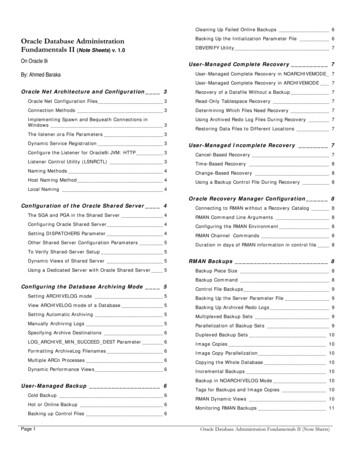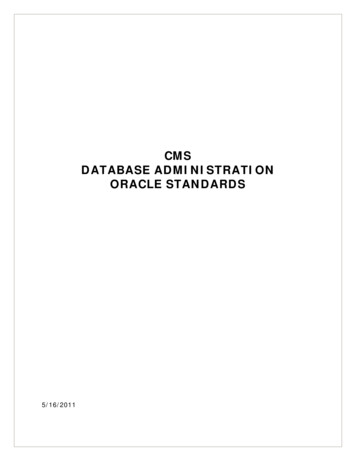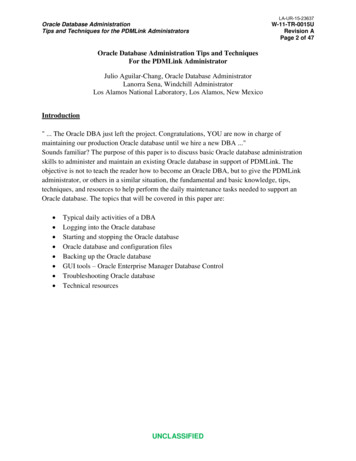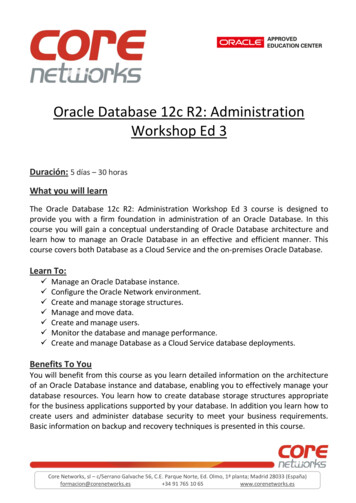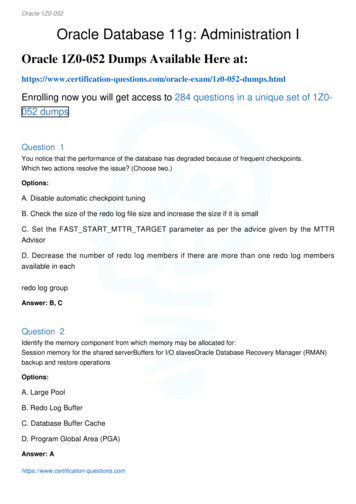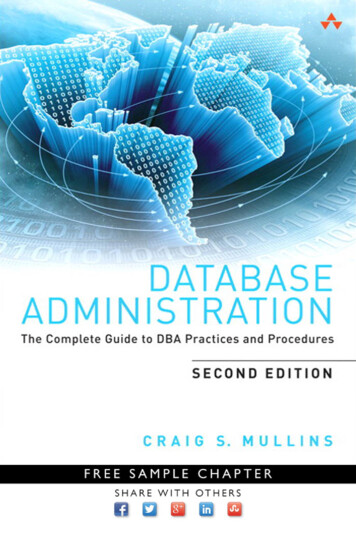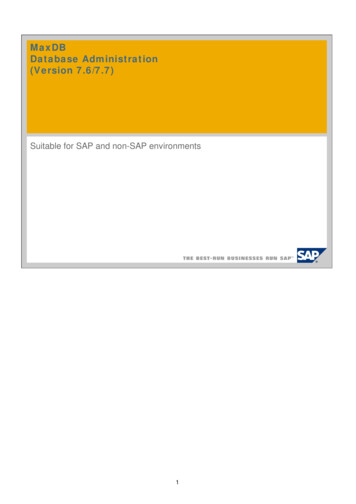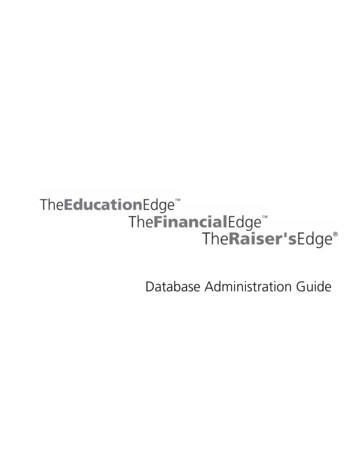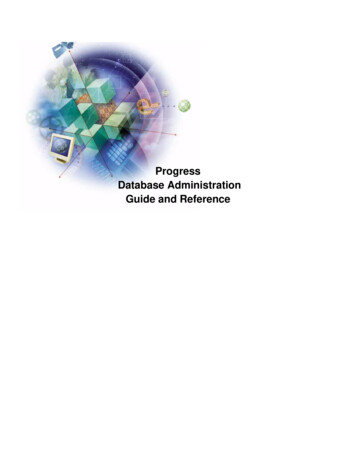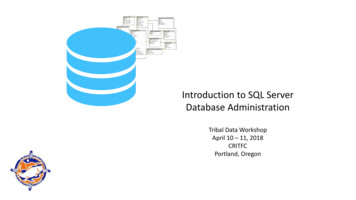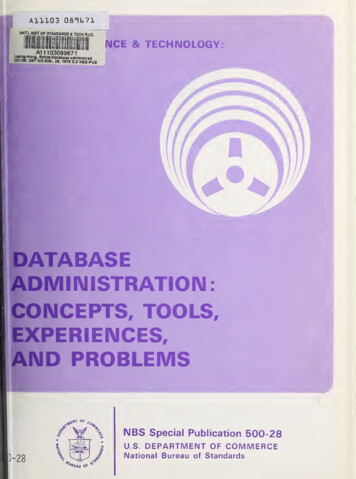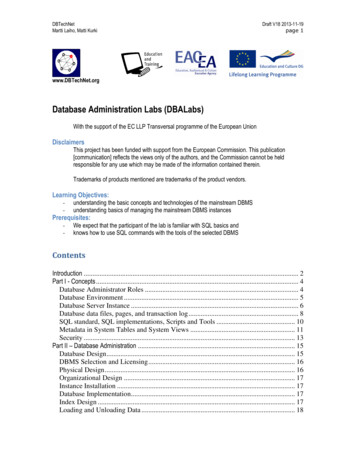
Transcription
DBTechNetMartti Laiho, Matti KurkiDraft V18 2013-11-19page 1www.DBTechNet.orgDatabase Administration Labs (DBALabs)With the support of the EC LLP Transversal programme of the European UnionDisclaimersThis project has been funded with support from the European Commission. This publication[communication] reflects the views only of the authors, and the Commission cannot be heldresponsible for any use which may be made of the information contained therein.Trademarks of products mentioned are trademarks of the product vendors.Learning Objectives:-understanding the basic concepts and technologies of the mainstream DBMSunderstanding basics of managing the mainstream DBMS instances-We expect that the participant of the lab is familiar with SQL basics andknows how to use SQL commands with the tools of the selected DBMSPrerequisites:ContentsIntroduction . 2Part I - Concepts . 4Database Administrator Roles . 4Database Environment . 5Database Server Instance . 6Database data files, pages, and transaction log . 8SQL standard, SQL implementations, Scripts and Tools . 10Metadata in System Tables and System Views . 11Security . 13Part II – Database Administration . 15Database Design. 15DBMS Selection and Licensing . 16Physical Design . 16Organizational Design . 17Instance Installation . 17Database Implementation. 17Index Design . 17Loading and Unloading Data . 18
DBTechNetMartti Laiho, Matti KurkiDraft V18 2013-11-19page 2Database Connectivity for Application Development . 18Consulting Application Developers . 18Production test and database rollout to production . 19Monitoring and Performance Tuning. 19Backup and Recovery . 22Disaster Recovery Planning . 23Data Reorganizing Management. 23DBMS Version Upgrades and Database Migrations . 25Reverse Engineering . 25Part III – Advanced Administration Topics . 26Distribution . 26Application Server Management . 26Data Warehousing Management . 26XML and Large Objects . 26Technology Trends . 26Review Questions and Exercises . 27Hands-on Labs to know your DBMS . 28References and Links . 29Appendix 1 First Steps in SQL Server Administration . 30SQL Server startup . 30Using SQL Server Management Studio . 31Defining SQL authentication and sa user . 31Creating a new database . 33SQL Server fixed and built-in roles. 39Monitoring and Tracing . 41Appendix 2 Table Reorganization Example in SQL Server 2008 . 45Appendix 3 SSMS as a Lower CASE Tool . 56Implementing a new table . 56Reverse engineering a part of the database . 59Generating Transact-SQL DDL commands. 61Index . 64IntroductionDatabases are everywhere from enterprise applications on mainframe computers to mobile phones. Even ifthe DBMS products are becoming quite automatically managed systems, the current mainstream DBMSproducts still need to be managed by database professionals, especially since the up-to-date data is a mostimportant asset of any company or organization.For database management many database related professional roles can be identified, such as Data Administrator (DA) System Analyst, Data Analyst Database Designer Database Administrator (DBA) System Administrator (SA)
DBTechNetMartti Laiho, Matti KurkiDraft V18 2013-11-19page 3which however are often in a small company combined to tasks of a single database professional typicallycalled as DBA.This tutorial provides an introduction to database administration, the duties and tasks of a databaseadministrator. We will focus on the management of multi-user online-transaction processing (OLTP)database servers. At the same time, this tutorial is a kind of umbrella tutorial, since for many of the topicswe have more detailed tutorials to which we often refer for more details.This tutorial is the first version of our vendor independent study material on database administrationfocusing on the “Big Three” DBMS products used by ICT industry - DB2, Oracle, and SQL Server.Future versions of this tutorial will be available at http://www.dbtechnet.org/labs/dba lab/DBALabs.pdfNote:In these tutorial versions of DBTechNet, with DB2 we mean DB2 for LUW (Linux, Unix or Windows)and not the mainframe editions of DB2, and all our DB2 examples have been tested using the freeDB2 Express-C 9.7edition, which has proved to be an excellent tool for self-studying purposes. OfOracle DBMS products, we use Oracle XE 10g, and of SQL Server product family we use SQLServer 2008 Express.As the main sources for compiling this material we have used manuals of the “Big Three” DBMS products,and the Web articles by Craig S. Mullins and his book “Database Administration” [1], which is based on hisexperience at BMC and contacts with BMC’s customer base and the mainstream of DBMS products.In this first version of the Database Administration tutorial, we try to provide at least an overview of theadministration tasks, and in the future we try to provide more detailed material with examples.The tutorial consists of three parts: Part I introducing concepts, Part II presenting the basic administration functions, and Part III just listing more advanced topics to be covered in future versionsplus appendices.The tutorial itself is generic in terms of the DBMS products, but in examples presented in appendices weuse the free SQL Server 2008 Express. The reasons for this are: it is free, it has excellent GUI tools foreducational purposes (although limited compared with the commercial editions of SQL Server), and it is notavailable on the free Linux platforms which we use in our free virtual laboratories. So the appendices atleast literal provide a short introduction to the concepts and tools of SQL Server, in case a student does nothave access to the actual software. Also to a new user the appendices will give a short “First Steps”introduction to SQL Server administration using snapshots of the tools which come with the commercialeditions of the product, which is widely used in ICT industry.The examples in the appendices may help an user of DB2 Express-C or Oracle XE in corresponding tasksproviding vision or models in search of solutions using facilities of these free products, which are available inour virtual laboratories.
DBTechNetMartti Laiho, Matti KurkiDraft V18 2013-11-19page 4Part I - ConceptsDatabase Administrator RolesDatabase administrator (DBA) is the job role of database professionals who plan, implement, control, andmaintain one or more database servers, quite often of different database management system (DBMS)products and editions. Due to the variety of types of organizations, applications and DBMS productmixtures, the DBA roles maybe of different types, such as- System management-oriented, such as a SAP R / 3 system administrator who is responsible forthe whole system environment; is expert in knowing the used DBMS product and the applicationserver(s); knows how to take technically care of the database; but who is not necessarily familiarwith the logical structures or content in the database of all those over 15 000 different tables.- DBMS product-oriented, typically a certified DBA of Oracle, DB2, or SQL Server.- Architecture/Technology-oriented specialist DBA who manages an "orchestra" of database serversof different DBMS products; supports, for example, sales organization; and controls remotelydatabase servers of customers.- Application oriented DBA who knows thoroughly the logical structure of the database of anapplication; perhaps supports, for example, sales organization; and controls remotely databaseservers of customers.- Management-oriented DBA role which also involves the administration of paperwork and records ofvarious topics, including license management, and user roles in organization and mapping of userroles to database roles, access control, authorization, and security architecture.These are covered in more details in Mullins’ article "Types of DBAs" athttp://www.craigsmullins.com/dbta 065.htmPartly based on Mullins' book [1], the responsibilities of different phases in database applicationdevelopment life cycle between the roles of Data Administrator (DA), Data Analyst / Database Designer /Data Architect, Database Administrator (DBA) and System Administrator (SA) can be seen according toTable 1, where “X” stands for the primary responsibility and “(x)” stand for a “vice responsibility”.Responsibility ofIT infrastructureData and Metadata PolicyRequirements AnalysisData AnalysisDatabase Modeling, DesignDevelopmentTestingImplementationMaintenance and TuningDA, Analyst,by le 1 Comparison of responsibilities of the DA, DBA, and SA rolesTasks of DBA roles can be performed as part-time or a full-time by one person or by a team.Development-oriented and production-oriented DBAs need different skills, as Mullins points out in his article“DBAs Need Different Skills in Development and Production” at http://www.craigsmullins.com/dbta 023.htm,
DBTechNetMartti Laiho, Matti KurkiDraft V18 2013-11-19page 5and in the article at http://www.craigsmullins.com/dbta 085.htm he lists "The 17 Skills Required of a DBA"covering also the most important duties of a DBA. In summary we can agree that a DBA has to be “Jack-ofall-Trades” as Mullins says. The following "DBA rules of thumb" characterize the work of a DBA as listed byMullins [1]1. Document everything2. Keep anything3. Automate!4. Share your knowledge5. Analyze, simplify, and focus6. Don't panic7. Measure twice, make it right at first time8. Understand your business, not just the technology9. Don't become a hermit, communicate10. Use all of the resources at your disposal11. Keep your knowledge up-to-date.The top priorities in the mind of a professional DBA are the reliability, security, integrity andrecoverability of data in the database without compromises. Then comes availability, performance, andsca
Database Administration Labs (DBALabs) With the support of the EC LLP Transversal programme of the European Union Disclaimers This project has been funded with support from the European Commission. This publication [communication] reflects the views only of the authors, and the Commission cannot be held responsible for any use which may be made of the information contained therein.
